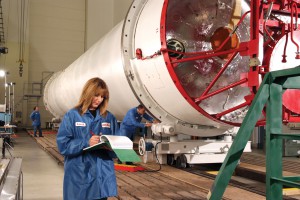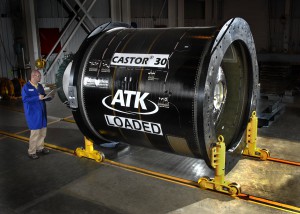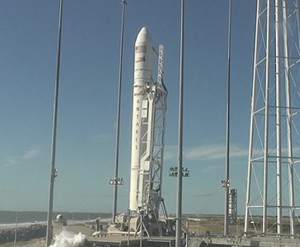Orbital reports the main engines chilldown procedure is proceeding as planned. We are 15 minutes from launch.
Author: Steven Siceloff
Range is Green
The range reports it is clear for launch. Liftoff remains on track for 10:58 a.m. EDT. Weather conditions and forecast look good, too.
About Antares
First Flight of Operational Cygnus
Today’s mission will be the first time an operational Cygnus flies in space. Once on its own in orbit, a pair of solar array wings will deploy from the base of the 17-foot-tall cylindrical spacecraft and it will go through a robust series of checks and evaluations to make sure its systems are ready to approach the station. A rendezvous with the orbiting outpost is scheduled for Sunday. Cygnus will get within reach of the station’s robotic arm. The arm will latch onto the spacecraft and pull it onto the Earth-facing port of the Harmony module.
Astronauts will unload about 1,300 pounds of cargo in the following days. Orbital Sciences developed Cygnus under NASA’s Commercial Orbital Transportation Services partnership. The spacecraft will be released to fly into Earth’s atmosphere and burn up to end the mission.
For a few quick facts about Cygnus from Orbital, click here.
Here’s how the typical Cygnus mission will unfold:
Viewing Antares Liftoff
Orbital Sciences offers this advice for those who may want to try to see the Antares rocket liftoff from Virginia’s Eastern Shore:
The trajectory will move southward as the window progresses. This means that for viewers north of the launch site (e.g. Annapolis) it will appear to be lower in the horizon; for viewers northeast of the launch site (e.g. Washington) it will appear to be further to the right; for viewers east of the launch site (e.g. Richmond) the trajectory will roughly follow the same path; for viewers south of the launch site (e.g. North Carolina) the trajectory will appear to be higher in the sky.
Please keep in mind that none of us really know how far away the rocket will be visible. The first stage of Antares is a liquid rocket, fueled by kerosene and liquid oxygen. The resulting exhaust is a combination of carbon dioxide and water vapor. As with a jet engine, under most circumstances the exhaust will not be visible, although if the atmospheric conditions are just right a contrail might be left behind. Most likely, if the vehicle can be seen at all during the first stage, it will look like a small bright dot with a small puff of smoke behind it. The second stage is a solid rocket which does leave a significant column of exhaust behind it. For most observers the vehicle will be quite far away at that point (500+ miles), however it is possible that if the day is very clear the smoke left behind will be visible.
One final note, if you witnessed the recent LADEE launch aboard our Minotaur V rocket, you should remember that the Antares rocket moves significantly slower than a Minotaur V in its ascent phase.
Today’s Mission Part of NASA’s COTS Agreement
NASA partnered with Orbital Sciences to develop the Cygnus cargo spacecraft for commercial missions to resupply the International Space Station. You can find out more details about the partnership here and in this fact sheet.
Welcome to the Countdown for Orbital’s Cargo Delivery Demonstration Mission!
Our launch is coming today from the Mid-Atlantic Regional Spaceport at NASA’s Wallops Flight Facility on the Eastern Shore of Virginia. Orbital Sciences is deep into the countdown for the launch of the company’s Antares rocket and Cygnus spacecraft to the International Space Station. Everything is proceeding well and launch remains on course for 10:58 a.m. EDT. The rocket is being fueled with kerosene and liquid oxygen propellants.
Orbital: Fuel and Lox Loading Underway
The Antares rocket’s first stage is being loaded with RP-1 kerosene and liquid oxygen, the propellants that will power the stage’s two Aerojet engines during the first phase of launch and ascent, Orbital Sciences reports. The company also reports that the systems on its Cygnus spacecraft are “green” and the spacecraft looks good. Launch time is 10:58 a.m. EDT.
New Launch Time: 10:58 A.M. EDT
The launch time for Orbital Sciences Antares/Cygnus liftoff is 10:58 a.m. EDT from the Mid-Atlantic Regional Spaceport at NASA’s Wallops Flight Facility in Virginia. Fueling of the Antares has begun. The chance of acceptable weather for launch remains 75 percent.




